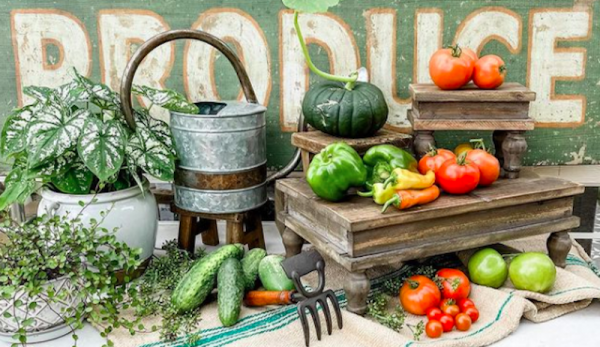
“The most important lesson learned from the farm is patience,” says Rhonda Kaiser, a certified Texas Master Gardener who runs Southern Home and Farm. “Farming and gardening are definitely trial and error. Every gardening zone is different, so you have to find what works best for you in your area.”
Pointing to her rural roots, Kaiser says that gardening has always been one of her passions. These days, she finds “peace of mind knowing how [my] crops and vegetables have been grown,” along with the accomplishment of nurturing seeds and watching them “blossom into thriving productive plants.”
“Gardening is my escape,” she adds. “It makes the world a more beautiful place!”
We spoke to Kaiser about repurposing vintage objects in the garden and the importance of thinking vertically when using your outdoor space. We also got the scoop on growing vine candy.
The Path to Becoming a Master Gardener
Originally, Kaiser says she was inspired to build on her love of gardening and follow in the footsteps of her husband’s grandmother, who owned a flower store in Bishop, Texas.
“Those paths led to a love of landscaping, which culminated in a Texas Master Gardener certification and landscape design classes through my alma mater, Texas A&M University,” she explains. “Someone recently asked me how I knew so much about gardening and I realized it was the development of years of schooling, in both experience and academia.”
Read more: Good gardening requires keeping the garden ready. Here are some tips for staying prepared.
The Importance of Patience
View this post on Instagram
When asked about early lessons for beginner farmers, Kaiser says that learning to appreciate the importance of patience is key. It’s also crucial to realize that your approach to working with the land will evolve over time.
“Follow experts in your area and never be afraid to ask questions,” she says. “That is how I learned some of my best techniques.”
Thinking Vertically in the Garden
View this post on Instagram
If your own gardening plans often seem constrained by a lack of space, Kaiser recommends starting to think vertically.
“Use items such as bean towers, A-frames, obelisks or trellises to optimize space,” she says. “You can even use arches to grow crops such as squash or cucumber. You don’t need to spend a lot of money—simple cattle panels formed into an arch shape [and] secured with garden stakes will do the trick.”
Kaiser also suggests embracing raised beds and pots. “The key to raised bed gardening is nutrient-rich soil,” she explains. “Plants will never thrive without a solid foundation. Think of the old gardening adage: Never put a $10 plant in a $2 hole.”
Read more: Growing pumpkins vertically solves a number of common problems.
Resourceful Repurposing
View this post on Instagram
“Regarding repurposing, I have used items such as vintage toolboxes, grain buckets, pottery jars and even an old pair of my father’s cowboy boots as containers,” says Kaiser when asked about some of the objects featured on her Instagram feed.
“I have also used antique bed frames for flower and herb beds,” she continues. “Other vintage items that make for unique planters include farmhouse sinks, vintage bed springs mounted vertically to hold a variety of small pots and small chicken coops. Vintage metal items, such as chairs or antique bicycles, can be used as climbing surfaces.
“Chicken wire can also be fashioned into any shape for a climbing surface as well.”
Growing Vine Candy
View this post on Instagram
When it comes to favorite crops, Kaiser points to tomatoes first, followed by asparagus.
“We grow multiple tomato varieties,” she says. “I love to use them in sandwiches, soups and stews. My favorite variety is Sweet 100 cherry tomatoes. They produce many tomato clusters and are known as vine candy for their sweet, sugary flavor. They best way to eat those is straight off the vine!”
Follow Southern Home And Farm on Instagram.




